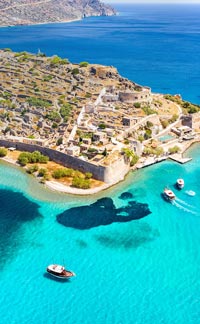The Ideon Cave, also known as Ideon Andron, is located in almost the exact geographical center of the Cretan land mass, on a high elevation on the east side of Mt. Psiloritis. While Psiloritis, highest point in Greece, is 2,456 meters high, the cave is at the 1500 meter elevation.
The claim is that this is where Rhea, mother of Zeus, hid her infant son so that his father, Cronus, would not swallow him as he had his other offspring. Cronus was swallowing his children because of a prophecy that one of his sons would overthrow him. The myth states that the Kouretes, mythical warriors who wore crests on their heads, performed their noisy war dance in front of the cave’s mouth in order to mask the infant Zeus’s cries from Cronus. Zeus survived, grew, and, true to the prophecy, eventually overthrew his father.
Ideon shares the claim to be the home of the infant Zeus with the Diktaon Cave, in east-central Crete, one difference being that in the Diktaon Cave, the actual spot where Zeus was born is specified, whereas in the Ideon Cave, Zeus is thought to have either been born there or to have spent his childhood there, or both. Other places thought to be Zeus’s birthplace are in eastern Turkey and on the island of Naxos.
The cave’s main chamber is 40 by 50 meters. There have been many excavations, starting with the Italian Frederico Halbherr, who seems to have been excavating everywhere in Crete, in 1884, and another by Yiannis Sakellarakis in 1982. Other excavations took place in 1917 and 1956.
The cave has seen substantial cultic worship over thousands of years. Yearly festivals were held there in the Minoan era worshipping the god of growing things and celebrating his rebirth and that of nature, in the spring. Young Zeus worship replaced that of the god of vegetation, with the myth of death and rebirth being transferred to the beardless young god. The philosopher Theophrastus (372-287 BC) writes that worshippers would hang offerings from the branches of a poplar tree growing in front of the cave entrance.
Items found in the cave include bronze figurines, brooches, bronze statuettes, tools, gold jewellery, and ceramics. Bronze shields have been found including one with an intricate hammered illustration of Zeus holding a lion over his head, standing over Crete’s sacred bull, and flanked by two helmeted Kouretes.
Pythagoras (580-496 BC) visited the cave and said that it contained an ivory throne, which has long since disappeared. In 1982 the nearby ancient settlement of Zominthos was discovered, dating to 1800 BC. A large, well-appointed building of 120 square meters was discovered. It is thought that it housed the priests and priestesses of the Ideon Andron during the winter months.




















